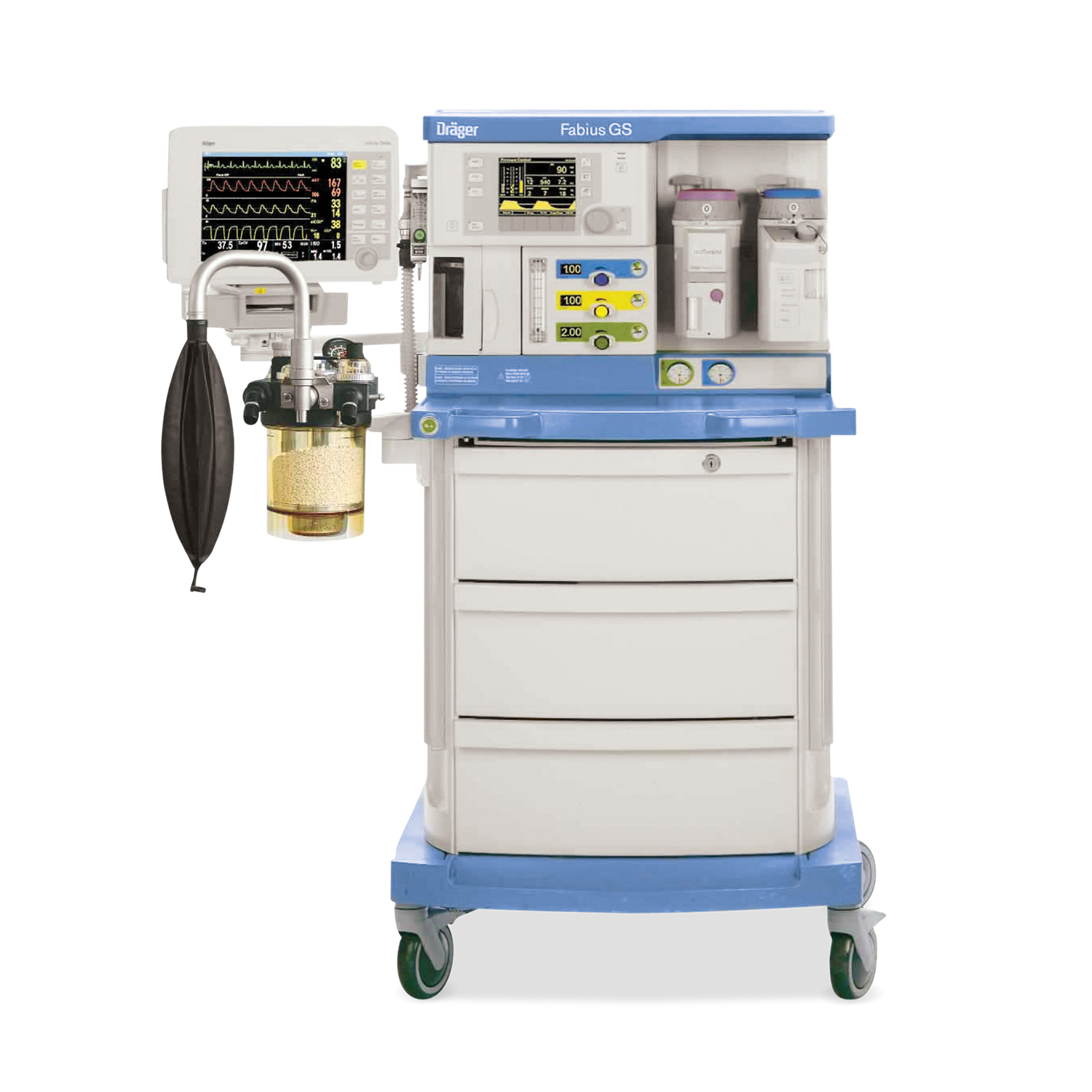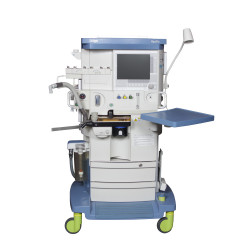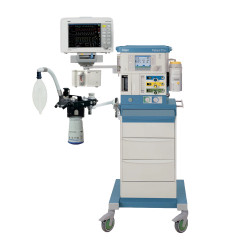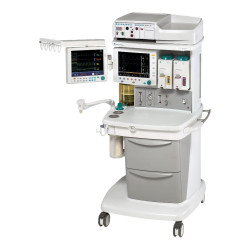Drager Fabius GS Máquina de Anestesia

Drager Fabius GS Máquina de Anestesia
0 Artículo está en su carrito Ver carrito ahora
Biomedical HTM Customers
Service, Repair & Parts
Términos y Condiciones del Listado
All product and company names are trademarks of their respective holders. Use of them does not imply any affiliation with or endorsement or sponsorship by them.
Details
La descripcion del producto no esta disponible en Español. Puede ver la version en Ingles abajo o puede contactarnos para hablar con un representante.
The Drager Fabius® GS combines advanced ventilation technology with reliable and proven breathing system components, opening new frontiers in ventilation performance while maintaining well-established functionality.
Proven Ventilation Versatility
The electrically driven and electronically controlled Fabius GS E-vent ventilator requires no drive gas. This makes it more flexible and economical to use than traditional gas-driven bellows ventilators by limiting the consumption of expensive medical grade gas to patient use only. Motor-driven hardware and software-controlled functionality also offer virtually unlimited upgradeability. The Fabius GS is suitable for any patient — pediatric to adult — and provides Volume Controlled Ventilation, Pressure Controlled Ventilation, Synchronized Volume Control (SIMV), Pressure Support and Manual/Spontaneous modes. Pressure Support mode facilitates spontaneous breathing by removing the work of breathing due to circuit resistance, improving comfort levels and enhancing quality of patient care.
Electronic Gas-Flow Measurement
The Drager Fabius GS is the world's first anesthesia machine with vertical flow controls and electronic fresh gas flow indicators, enabling you to compare gas flows more easily and intuitively. Additionally, the export of fresh gas data to an information system allows monitoring of gas usage and to promote the use of low-flow anesthesia.
Compact, Convenient Breathing System
The flexible, ergonomic design of the Fabius GS allows for optimal positioning of the semi-closed breathing system (COSY). The COSY can be height- adjusted, pre-assembled on the left or right side of the machine and can be easily removed from the machine for cleaning and sterilization. The COSY not only minimizes set-up and installation time but also substantially reduces the potential for leaks, OR pollution and overall gas consumption. It is simply a smarter and much more ergonomic design.
Intelligent Cable Management
The Infinity monitoring line offers an outstanding cable management approach: The MultiMed® parameter module reduces cable clutter and simplifies patient transfer. Moreover the unique Pick and Go® capabilities of the Infinity patient monitoring system provide continuous monitoring during transport and automatic reconfiguration of site specific parameters with Dräger Medical's innovative Infinity Docking Stations (IDS).
Universal Mounting Platform
The Pick and Go concept also provides significant efficiency and quality benefits. Because the monitor moves with the patient, no separate transport monitor is required and you will need fewer monitors throughout the patient care process. The choice of a fixed-mount monitoring solution or the Pick and Go transport concept gives you maximum flexibility to adapt your complete anesthesia solution to today's evolving requirements.
ClinicalVision™
Our latest monitoring solutions allow you to choose the high efficiency data-access tools that make the most sense for your viewing needs. The new Infinity Omega solution uses a two-screen system approach so you can see patient monitoring data and clinical data simultaneously. It includes a Delta patient monitor with the Infinity Docking Station and a 17" touch screen smart display all to help eliminate information access bottlenecks, keep you confidently on top of your entire environment and offer maximum flexibility for your longterm IT needs. With an optional web browser you can access web-based applications as well.
Drager Fabius GS Safety Functions
Sensitive Oxygen Ratio Controller (S-ORC) guarantees a minimum O2 concentration of 23% in an O2/N2O mixture. N2O cut-off if O2 fresh gas valve is closed or if O2 flow is less than 0.2 L/min. Audible and visual (flashing red LED) indication in case O2 pressure drops below 20 psi (1.38 bar) ± 4 psi (0.27 bar).
In case of electricity and battery failure, manual ventilation, gas delivery and agent delivery are possible. Positive pressure relief valve opens at 75 ± 5 cmH2O. Negative pressure relief valve opens at - 7.5 to - 9 cmH2O
Specifications
General
- Height: 51.2 inches (130 cm)
- Width: 35.2 inches (89.5 cm)
- Depth: 32.3 inches (82 cm)
- Weight (base unit without vaporizers or cylinders): 224 lbs (101.6 kg)
- Power Supply: 100-240 VAC, 50/60 Hz, 2.3 A max.
- Battery (supports ventilator and monitor): > 45 min
- Ventilator E-vent: Electronically controlled, electrically driven
- Breathing Frequency: 4 to 60 bpm
- Max. Minute Volume (MV): 25 L/min
- Positive End-Expiratory Pressure (PEEP): 0-20 cmH2O
- Inspiration/Expiration Ratio (Ti:Te): 4:1 to 1:4
- Pressure Limiting (Pmax): 15-70 cmH2O
- Tidal Volume (Vt): 20-1400 mL in Volume Control; 20-1100 mL in SIMV/PS
- Inspiratory pause (Tip:Ti): 0-50%
- SIMV Inspiratory Time (Tinsp): 0.3-4.0 sec
- Inspiratory Pressure (Pinsp): PEEP + 5 to 65 cmH2O
- Inspiratory Flow (InspFlow): 10-75 L/min in Volume and Pressure Control, 10-85 L/min in Pressure Support
- Pressure Support Level (ΔPPS): PEEP + 3 to 20 cmH2O
- Min. Frequency for Apnea-Ventilation (Freq. Min.): 3-20 bpm and "OFF"
- Trigger: 2-15 L/min
- Range of Fresh Gas Flow Indicators: 0.00 to 12.0 L/min
- Total Fresh Gas Flow Meter: 0 to 10 L/min, calibrated with a mixture of 50 % O2 and 50 % N2O mixture
- O2 Flush: at 87 psi (6 bar): max.75 L/min, at 41 psi (2.8 bar): min 25 L/min
- Vaporizer Mount: Dräger or SelectatecR mount
- Serial Interface: 1 x RS 232 (standard), 1 x RS 232 (option)
- Protocols: Vitalink and Medibus
- Data Available for Export: All fresh gas flow, ventilation and O2 data
- Volume of CO2 Absorber: 1.5 Liter, option: Dräger medical's consumable CLIC adsorber
- Volume of Entire compact Breathing System: 2.8 Liter + bag
Monitoring
Continues monitoring of inspiratory O2 concentration (can be switched off by Service) breathing frequency, tidal volume, minute volume, mean or plateau pressure, peak airway pressure as well as PEEP. In addition, all fresh gas flow information is displayed as virtual flow tubes.
Operating Modes
- Standard: Manual/Spontaneous, Volume Control (IPPV)
- Options: Pressure Controll (PCV), Pressure Support (PS), Synchronized Volume Controlled Ventilation with PS (SIMV/PS)


